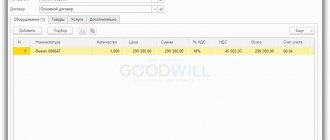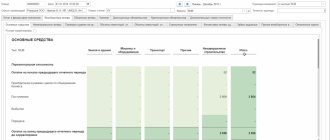Accounting and tax accounting in an organization
Any accountant probably knows that there are several types of accounting, the most common (and probably the most important) of which are accounting and tax.
Take our proprietary course on choosing stocks on the stock market → training course
Accounting is a reflection of the entire economic life of an organization through primary documents. When maintaining accounting records, all events that occur in the life of the company are taken into account. The purpose and outcome of operations in the field of accounting is the preparation of annual reports. The year-end financial report is prepared for:
- Internal users. Their role is played by the owners or top managers of the company. Based on the report data, they draw conclusions about the success of the organization during the year and make the necessary decisions
- External users. These include primarily creditors and tax authorities.
Based on the accounting report, the state of the organization and its development prospects are assessed. Reporting helps make important management decisions .
The main documents regulating accounting are the Law “On Accounting” and the Accounting Regulations (PBU).
Tax accounting is a system that is built on the basis of primary documents and summarizes information that is used to calculate the amount of taxes.
The lion's share of all tax accounting is the calculation of income tax. The main act that regulates this type of accounting is the Tax Code .
The main feature of tax accounting is that not all transactions reflected in accounting are accepted for calculating the amount of tax liabilities. Some expenses are not accepted at all, while others are rationed.
| Business valuation | Financial analysis according to IFRS | Financial analysis according to RAS |
| Calculation of NPV, IRR in Excel | Valuation of stocks and bonds |
Types of differences that may arise during operation
Due to the fact that for accounting purposes all amounts of income and expenses are accepted, and for tax purposes only selectively, differences arise when calculating income tax. These differences can lead to either a tax decrease or an increase. Moreover, in both cases, the tax change can be either permanent or temporary . If such differences arise in the company, then the following entries are generated in accounting:
- Calculation of income tax, reflects the organization's debt to the budget D99 K68.04
- If there are differences that increase tax:
– constantly D99 K68
– temporarily D09 K68
- If there are differences that reduce tax:
– constantly D68 K99
– temporarily D68 K77
It must be taken into account that accounts 09 and 77 are subsequently closed with reverse entries.
| IMPORTANT! Temporary differences do not affect the company's net profit |
Let's look at what the differences look like using an example. Initial data:
revenue 150 thousand rubles, cost 50 thousand rubles, wage fund 20 thousand rubles, artificial fountain in the director’s office 30 thousand rubles, gratuitous receipt from the founder 50 thousand rubles, fines and penalties for taxes 30 thousand roubles.
| Index | Accounting | Tax accounting |
| Revenue | +150 | +150 |
| Cost price | -50 | -50 |
| Payroll fund | -20 | -20 |
| Fountain | -30 | – |
| Proceeds from the founders | +50 | – |
| Fines, penalties | -30 | |
| Profit before tax | +70 | +80 |
It turns out that according to accounting data, it would be necessary to pay less tax than required by tax accounting. Taking into account the differences, accounting data must be brought to the same level as tax accounting data.
It must be borne in mind that the amount of income tax for transfer to the budget is calculated as conditional income (that is, the profit before tax that is obtained according to accounting data), adjusted for all resulting differences. If everything is done correctly, the tax received by this calculation will coincide with the amount of tax according to the declaration.
Conclusions about what a change in indicator means
If the indicator is higher than normal
Not standardized
If the indicator is below normal
Not standardized
If the indicator increases
Usually a positive factor
If the indicator decreases
Usually a negative factor
Notes
The indicator in the article is considered from the point of view not of accounting, but of financial management. Therefore, sometimes it can be defined differently. It depends on the author's approach.
In most cases, universities accept any definition option, since deviations according to different approaches and formulas are usually within a maximum of a few percent.
The indicator is considered in the main free online financial analysis service and some other services
If you need conclusions after calculating the indicators, please look at this article: conclusions from financial analysis
If you see any inaccuracy or typo, please also indicate this in the comment. I try to write as simply as possible, but if something is still not clear, questions and clarifications can be written in the comments to any article on the site.
Best regards, Alexander Krylov,
The financial analysis:
- I. NON-CURRENT ASSETS Non-current assets are property used in the activities of an enterprise for more than a year. Its value is transferred in parts to the cost of finished products. A sign of assets is the ability to generate income for the organization.…
- Balance sheet asset A balance sheet asset is a part of the balance sheet containing data on the assets of the enterprise, that is, on its property. The balance sheet asset reflects property, property rights and cash...
- IV. LONG-TERM LIABILITIES Section IV. Long-term liabilities are the fourth section of the balance sheet. At the same time, it is also the second section of the liability side of the balance sheet, which shows the sources of financing for the property. AND…
- Key performance indicators of an enterprise Key performance indicators of an enterprise are indicators that allow us to judge several things: The size of the enterprise and the scale of its activities The level of income and expenses About ...
- Absolute economic indicators of an enterprise's activity Absolute economic indicators of an enterprise's activity are indicators that allow us to judge several things: The size of the enterprise and the scale of its activities The level of income and expenses...
- Balance sheet liability The balance sheet liability is the second part of the balance sheet. It contains a list of those financial resources that were used to acquire property, that is, assets that...
- Relative economic indicators of the enterprise’s activity Relative indicators of the enterprise’s activity are indicators that allow one to judge the efficiency of work. The initial data for the preparation of such indicators can be taken from the balance sheet and report on ...
- II. CURRENT ASSETS Current assets are property used in the activities of an enterprise for less than a year or used in one production cycle, which also does not exceed one year. Its entire cost...
- III. CAPITAL AND RESERVES Section III Capital and Reserves is the third section of the balance sheet. But what is more important is the first section of financial sources, that is, the liability side of the balance sheet. By this he...
- V. CURRENT LIABILITIES Section V. Current liabilities is the fifth section of the balance sheet. At the same time, it is also the third section of the liability side of the balance sheet, which shows the sources of financing for the property. AND…
The concept of deferred tax assets (DTA)
Deferred tax assets are formed due to differences in the values of indicators in tax and accounting. When such assets arise, there is a temporary tax increase, which means that the tax deduction will be made later .
Deferred tax assets are often created when depreciation is calculated. However, after the object is completely depreciated, the difference will disappear, and, therefore, the deferred asset.
Another interesting case is advertising costs. They are standardized except for cases where advertising is placed in the media, at exhibitions or fairs. At the same time, advertising expenses can be taken into account in tax accounting in the amount of 1% of revenue. That is, if advertising costs 100 thousand rubles, and 1% is 80 thousand rubles, then the difference between the two types of accounting in the company will be 20 thousand rubles, the tax on it is 4 thousand rubles. and for this amount it is necessary to create a deferred tax asset.
It is also very important to remember that if at the end of the period there is a loss, then you can submit a declaration with zero profit, and form a deferred tax asset for the amount of the loss.
Deferred tax asset accounts
The accounting entries relating to deferred tax assets have already been given above.
As you can see, when such assets arise, two accounts appear:
- Account 68 with the corresponding subaccount. The credit of the account reflects our income tax debt to the budget and the creation of a deferred tax asset
- Account 09, which is called “Deferred tax assets”. The debit of the account reflects the creation of an asset, and the credit reflects its closure
In the explanation to the financial statements of the first two forms, it is necessary to reflect information about contingent expenses, differences and accrued deferred assets.
Reflection of SHE in the balance sheet of the organization
In the balance sheet, such assets are reflected in balance sheet asset line 1180.
It must be borne in mind that information on this line can be specified without detail. Moreover, in collapsed form, the amount of deferred tax assets is indicated only if they are taken into account when calculating income tax.
The amount of the deferred tax liability is the balance in the debit of account 09.
In order to find the amount of such an asset by calculation, you need to multiply the temporary difference in expenses by the approved income tax rate.
In addition to being reflected in the balance sheet, deferred tax assets are indicated in Form No. 2. To do this, the change in the deferred asset is calculated as the difference between the credit and debit closing balance of account 09. In this case, the sign of the calculation result does not change.
What is referred to as SHE
According to PBU 18/02, ONA should include that part of the deferred income tax, which in the future will lead to a decrease in the amount of the fiscal liability payable to the state budget. For example, in the next reporting period or in subsequent periods of time.
In simple terms, IT is part of an enterprise’s expenses that can be taken into account as part of expenses that reduce the taxable base for income tax, but in a given reporting period they cannot be accepted in full. Consequently, such expenses are partially accepted in this reporting period, and the balance is transferred to subsequent ones.
Also, some types of company income that were accepted into NU earlier than in accounting can be included in ONA. Such income is subject to write-off when accepted into the accounting system.
An example of calculating and reflecting the amount of deferred tax assets in the balance sheet
Let's give a small example of calculating deferred assets and take the most common cases - advertising expenses and depreciation.
| Operation | Accounting | Tax accounting | Difference | Tax rate 20% | Wiring |
| Advertising expenses | -200 | -150 | 50 | 10 | D09 K68 |
| Depreciation | -2667 | -2000 | 667 | 133 | D09 K68 |
We show the indicator values with a minus, so these are the expenses incurred. By posting, we accrue the amount of the deferred tax asset, which will be taken into account in the following periods. Accordingly, according to advertising, the value of the deferred asset is 10, and according to depreciation, 133.
The accounting “plane” for account 09 will be the following scheme:
| Debit | Credit |
| 10 | |
| 133 | |
| Turnover 143 | |
| Final balance 143 |
The amount of the final balance is the organization's prepayment for the future. This amount must be reflected in the balance sheet.
At the same time, the value of these assets, along with other indicators, is reflected in the credit of account 68.
Reflection in reporting
If according to 09 as of December 31 of the reporting year there is a balance, it will have to be reflected in the financial statements. Moreover, the company must independently determine the method of reflecting information in the accounting reports.
Currently, it is permissible to use two methods: expanded and shortened. The decision about which method the company decided to use must be indicated in the explanatory note to the financial statements (balance sheet and income statement). Let's consider how to reflect IT in the balance sheet for each option.
Option No. 1. Expanded
If the company has decided to reflect the information in an expanded manner, then reflect the debit balance on account 09 in line 1180.








